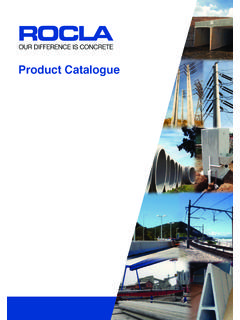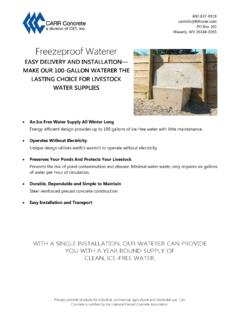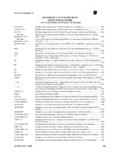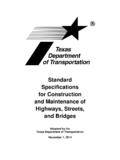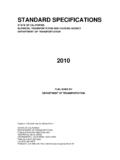Transcription of CONCRETE PIPE AND PORTAL CULVERT HANDBOOK
1 5th Edition , Infrastructural Products and Engineering Solutions DivisionCONCRETE pipe AND PORTAL CULVERT HANDBOOK5th Edition 2009 Published byConcrete Manufacturers AssociationBlock D, Lone Creek, Waterfall Office Park,Bekker Road, MidrandTelephone: +27 11 805 6742 Fax: +27 86 524 9216 Email: Edition 2009 PREFACEC oncrete pipes and PORTAL culverts are the most frequently used and accepted products for stormwater drainage, culverts, outfall sewers and many other applications. To meet these needs South Africa s CONCRETE pipe industry has grown tremendously over the past eighty technology and the acceptance of SABS standards ensure that products with consistently high quality are produced. Provided sound design and installation methods are followed, these products will give the desired hydraulic and structural performance over a long service HANDBOOK is intended to cover all aspects of CONCRETE pipe and PORTAL CULVERT selection, specification, and testing.
2 As a HANDBOOK it does not attempt to replace textbooks or codes, but rather to complement them by providing the information needed for quick site decisions and guidance for designers to ensure that all aspects of product use are considered. A companion publication The CONCRETE pipe and PORTAL CULVERT Installation Manual deals with product by the American CONCRETE pipe Association have been used freely and acknowledgement is hereby made to this Pipes, Infrastructural Products and Engineering Solutions (PIPES) Division of the CONCRETE Manufacturers Association has had this HANDBOOK prepared for the guidance of specifying bodies, consultants and contracting organisations using CONCRETE pipes and PORTAL culverts manufactured in accordance with the relevant SABS standards. The Division expresses appreciation to Dutton & Partners for the preparation of the original CONCRETE pipe HANDBOOK to which additions and amendments have been made to produce this by A.
3 GoynsPIPES ccP O Box 12519 Clubview001415th Edition 20091. INTRODUCTION OBJECTIVE SCOPE 22. PRODUCT CLASSIFICATION STANDARDS CONCRETE PIPES PORTAL CULVERTS MANHOLES 63. HYDRAULICS CONDUIT CLASSIFICATION HYDRAULIC LENGTH PRESSURE PIPELINES SEWERS AND STORMWATER OUTFALLS HYDRAULICS OF STORMWATER CULVERTS POROUS PIPES 154. LOADS ON BURIED PIPELINES INTRODUCTION EARTH LOADS TRAFFIC LOADING 215. CONCRETE pipe STRENGTHS EXTERNAL LOADS INTERNAL PRESSURE SAFETY FACTORS SELECTION OF THE CONCRETE pipe CLASS 256. BEDDING GENERAL TRENCH AND NEGATIVE PROJECTION INSTALLATIONS POSITIVE PROJECTION INSTALLATIONS SOILCRETE BEDDING JACKING CONDITIONS 327. pipe JOINTING JOINT TYPES BUTT AND INTERLOCKING JOINT PIPES SPIGOT AND SOCKET JOINTS IN-THE-WALL JOINTS 338. FLOATATION GENERAL FLOATATION BEFORE BACKFILLING FLOATATION AFTER BACKFILLING 349.
4 SEWER CORROSION CORROSION MECHANISM CORROSION PREDICTION AND CONTROL DEVELOPMENTS IN SOUTH AFRICA DESIGN AND DETAIL CONSIDERATIONS pipe MATERIAL CHOICE FOR SEWERS SACRIFICIAL THICKNESS AND ALLOWABLE CRACK WIDTHS 4110. PORTAL CULVERT STRENGTHS GENERAL DETERMINING PORTAL CULVERT STRENGTHS PORTAL BASE SLABS 4411. FIELD TESTING WATER TEST AIR TESTING SOIL DENSITY TEST 45 BIBLIOGRAPHY 4725th Edition OBJECTIVEThe purpose of this HANDBOOK is to give the users, designers, specifiers and installers of precast CONCRETE pipe and PORTAL culverts the basic guidelines for the correct use, selection and specification of these products. A companion publication The CONCRETE pipe and PORTAL CULVERT Installation Manual gives details of how these products should be SCOPEThe content of this HANDBOOK covers the pre-construction activities associated with precast CONCRETE pipe and PORTAL culverts, namely those undertaken by the designer of the project.
5 Descriptions are given of the basic theory needed for determining: product size product strength product durability special product featuresThe basic formulae, diagrams and tables support this. This information is adequate for most product applications. However, the theory given is by no means rigorous. The reader is advised to consult the relevant textbooks or codes, should a detailed analysis be required. A list of useful publications is given at the end of this STANDARDST here are three groups of standards which are applicable to precast CONCRETE pipe and PORTAL culverts, namely: Codes of practice that detail how product size, strength and durability should be selected. Product standards that prescribe what product requirements have to be met. Construction standards that prescribe how products should be South African Bureau of Standards (SABS) has been restructured.
6 The division dealing with the production of standards is Standards South Africa (StanSA). All the previously designated SABS standards are to be renamed as South African National Standards (SANS) and will retain their numbers. This document uses the latter. The division dealing with the issuing of manufacturing permits and the auditing pf production facilities is Global Conformity Services (GCS). The products covered by this publication comply with the requirements of relevant (SANS) document. These are performance specifications that detail the properties of the finished products needed to ensure that they are suitable for their required application. All these standards have the same basic layout, namely: Scope Normative references Definitions Materials used Requirements to be met Sampling and compliance Inspection and test methods Marking Normative and informative factories operated by the PIPES Division member companies have approved quality management systems to ensure that products comply with the relevant SANS specifications.
7 In addition to this GCS, does frequent audits to check that standards are being maintained. These standards are periodically reviewed to ensure that marketplace requirements are CONCRETE StandardsCurrently there are two South African national standards applicable to CONCRETE pipe : SANS 676 - Reinforced CONCRETE pressure pipesSANS 677 - CONCRETE non-pressure pipesThe code of practice for the selection of pipe strength is:SANS 10102 - Part 1: Selection of pipes for buried pipelines: General provisions - Part 2: Selection of pipes for buried pipelines: Rigid pipesThere are no standards for determining the size or durability of CONCRETE pipe . If the reader requires more detail than given in this publication, reference should be made to the appropriate literature, some of which is detailed at the end of this standards for the installation of CONCRETE pipe are included as sections in SANS 1200 standardized specification for civil engineering construction.
8 These sections are:2. PRODUCT CLASSIFICATION35th Edition 2009 SANS 1200 DB - Earthworks ( pipe trenches)SANS 1200 L - Medium pressure pipe linesSANS 1200 LB - Bedding (pipes)SANS 1200 LD - SewersSANS 1200 LE - Storm water drainageSANS 1200 LG - pipe pipe classesNon-pressure pipePipes are classified in terms of their crushing strength when subjected to a vertical knife-edge test-load. The two alternative crushing load test configurations are shown in Figure 1 (a) & (b).The proof load is defined as the line load that a pipe can sustain without the development of cracks of width exceeding mm or more over a distance exceeding 300 mm, in a two or three edge bearing test. Non-reinforced pipes are not permitted to crack under their proof ultimate load is defined as the maximum line load that the pipe will support in a two or three edge-bearing test and shall be at least times the proof load.
9 The standard crushing load strength designation is the D-load (diameter load). This is the proof load in kilonewtons per metre of pipe length, per metre of nominal pipe diameter. The standard D-load classes with their proof and ultimate loads are given in Table three edge-bearing test is preferred as the pipe is firmly held in place by the bottom two bearers before and during the test. With the two-edge bearing test there is the danger that the pipe could slip out of the testing apparatus or might not be perfectly square when tested. (a) Two edge bearing test(b) Three edge bearing testPipes made in accordance to SANS 677 are divided into two types, SC pipes for stormwater and CULVERT applications SI pipes for sewer and irrigation pipes are used in applications where there is no internal pressure. A small sample ( 2%) of pipes is subjected to the crushing strength test to prove that they meet the strength required.
10 SI Pipes, on the other hand, are used in applications where there could be internal pressure under certain conditions (as when blockages occur). To ensure that the pipes will meet this possible condition and ensure that the joints are watertight, a small sample of pipes is hydrostatically tested to a pressure of 140 kilopascals in addition to the crushing strength 2 gives proof loads of the preferred nominal diameters given in SANS 676 and Class D-Load Proof load kN/m Ultimate load : For a 1050 mm diameter 75D pipe proof load = x 75 = kN/m ultimate load = x = kN/mTABLE 1: STANDARD D-LOAD CLASSIFICATION FOR CONCRETE PIPESN ominal PipeDiameter-mmD Loads in 2: PREFERRED CONCRETE pipe DIAMETERS AND PROOF LOADS IN- KN/MFigure 1: Crushing load test configurations for CONCRETE pipe45th Edition 2009 Notes 1) Pipes with diameters smaller than 300 mm, or larger than 1 800 mm are made at some ) Strengths greater than 100D can be produced to ) Most pipes are made in moulds with fixed outside diameters.
